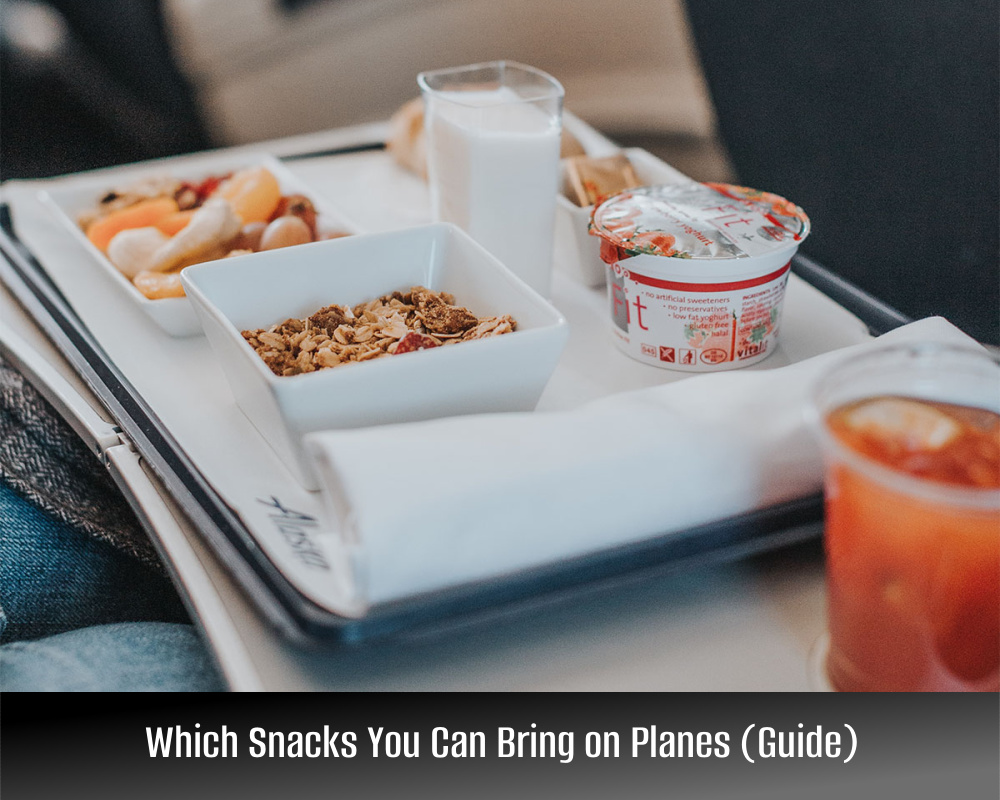Airplane food is expensive. And more often than not, it also isn’t very healthy or delicious. That’s why smart travelers usually bring their own food.
But the main problem with it is that not all snacks are allowed on planes. To enjoy a good and cheap meal during the flight, you should learn which snacks are allowed and which aren’t.

Which Snacks Are Allowed on Planes Without Any Restrictions
Out of all the snack ideas that you could come up with, only a few are restricted. Down below, you’ll find a list of snacks that you can bring in hand or checked baggage without any quantity, size, or packing restrictions.
- Potato chips
- Sandwiches, wraps, pizza, and similar items
- Nuts, dried berries, and dried fruit
- Cookies and pastries
- Beef jerky
- Candy
- Homemade food that doesn’t contain liquids
- Most processed snacks that don’t contain liquids
Which Snacks Have Restrictions
Some snacks are restricted by flight authorities, airport security, or customs & immigration. They’re mostly restricted due to security threats, but also to prevent the spreading of pests and diseases to other countries or states.
Fruit, Vegetables, Raw Meat, and Eggs (Only on International Flights)
If you’re flying domestically or within the European Union, these rules don’t apply. This means that you’re allowed to pack fresh fruit and vegetables for your flight.
If you’re flying internationally or entering/exiting the EU, you won’t be allowed to enter the country with fresh fruit, vegetables, raw meat and seafood, and eggs. Once you land, you’ll have to go through customs and immigration. If you have any of these items, the customs officers will confiscate them. You’re allowed to bring them for consumption during the flight – but you have to eat or dispose of them before going through customs.
This is to prevent spreading diseases, pests, and invasive species. Cooked meat, fish, vegetables, fruit, and eggs don’t have any restrictions because they’re processed.
All Liquids, Pastes, and Gels
Peanut butter, hummus, dips, yogurt, spreads, soups, liquid chocolate, cream cheese, milk, and canned foods are restricted to small quantities in hand baggage. They must be in 3.4 oz (100 ml) containers or smaller and you have to pack them together with your liquid toiletries in a 1-quart bag. If packed in checked baggage, there aren’t any restrictions.
To determine if your snack counts as a liquid, turn it upside down or shake it. If it moves by itself, it isn’t considered a liquid. For example, solid cheese, chocolate, cheesecake, and similar snacks aren’t considered liquids.
There are also certain liquids that are exempt from this rule. If you buy something in duty-free shops larger than 3.4 oz (100 ml), you’ll be allowed to bring it on the flight. Breast milk, baby food, ice packs, and frozen liquids also can be brought in larger quantities.
Alcoholic Beverages
In hand luggage, only 3.4 oz (100 ml) bottles are allowed, unless you purchased them in the airport at the duty-free shops. But for this to work, you’ll need to keep the receipt.
In checked baggage, most wines, beers, ciders, and champagnes are allowed in any quantity. Stong alcohol between 24-70% is limited to 5 liters per passenger. Alcohol over 70% and homemade alcohol are banned from checked and hand baggage.
Powders
Protein powder, spices, salt, sugar, and other powdered foods are generally allowed both in hand and checked bags. But if you’re bringing powdered food over 350 g (12 oz), you should pack it in checked baggage. When packed in hand baggage it might be subject to inspection or banned altogether.
Vitamins and Supplements
You’re free to pack most supplements and vitamins in hand and checked baggage without any restrictions. This includes capsules and tablets. But preferably, you should keep them in the original packaging to avoid additional inspections.
TSA-Approved Snack Ideas
- Dried fruits, berries, and nuts
- A Tupperware container filled with sliced fruits and vegetables. Combine that with a small container of hummus in your toiletry bag
- Aluminum foil-wrapped sandwiches, tortillas, or burgers
- Beef jerky
- Cookies, crackers, and candy
- Your own home-cooked meal in a Tupperware container (for example, boiled rice, fried chicken, and salad). Metal forks and spoons are allowed in hand baggage
How to Pack Snacks in Your Luggage
When boarding the flight, you can keep a small amount of snacks in the pockets of your jacket. This will allow you to save some space in your carry-on and personal item. It’s a trick that I often do myself on return flights when I’m short on space.
But if you aren’t short on space, it’s advised to pack your food in your personal item, not carry-on. That’s because you’ll be able to access it while the seatbelt sign is still switched on if you’re hungry.
To pack homemade food, you can use Tupperware containers, Ziploc bags, or wrap it in aluminum foil.
Summing Up: Traveling With Your Own Snacks
As far as TSA is concerned, you can bring any snack as long as it isn’t a liquid. This means that most homemade foods are allowed.
But that doesn’t mean that you should bring any food that you can think of. You should avoid smelly foods containing garlic or ones that are very messy to consume.
Instead, go for something simpler, like a sandwich, wrap, or a slice of pizza. You can complement that with something healthy, like nuts, dried fruits, and sliced veggies/fruit. I usually pack something like this to save money on expensive (and not that good) airline meals.
